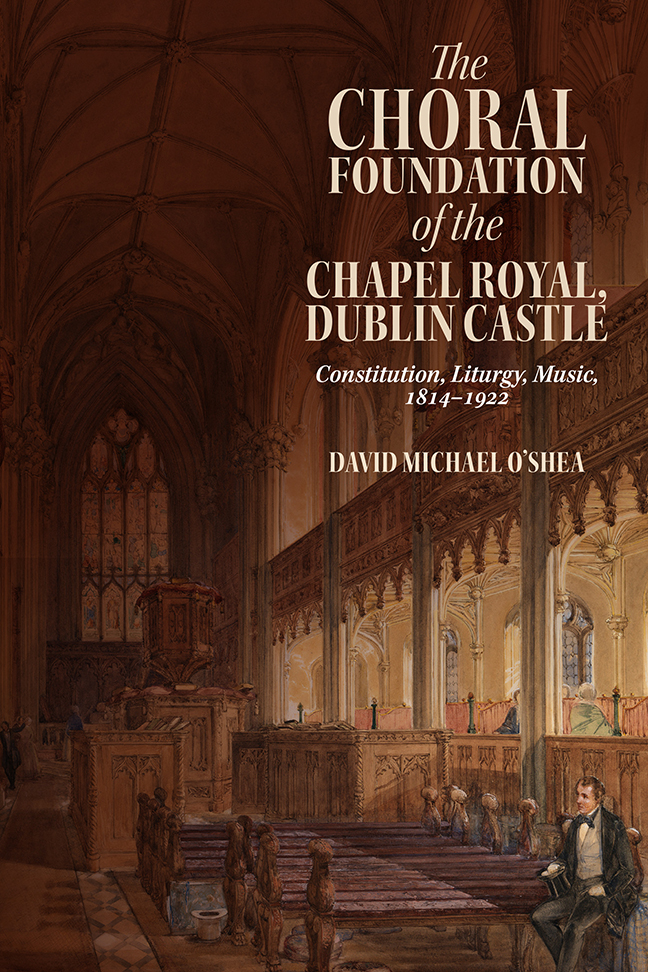Book contents
- Frontmatter
- Contents
- Illustrations
- Foreword
- Preface
- Acknowledgements
- A Note on Terminology
- Abbreviations
- Introduction
- 1 Precedents, Polity and Politics
- 2 Clergy
- 3 Churchmanship, Furnishings and Functions
- 4 The Musical Foundation
- 5 The Chapel Royal Music Collection
- 6 Singing the Liturgy
- 7 Organs
- 8 Boy Choristers
- 9 Gentleman Singers
- 10 Organists and Composers
- 11 The Chapel Royal's Legacy
- Conclusion
- Appendix A Lords Lieutenant, 1801–1922
- Appendix B Clergy of the Chapel Royal
- Appendix C Extant Chapel Royal Music Volumes (RCB MS 1113)
- Appendix D Boy Choristers of the Chapel Royal
- Appendix E Gentlemen Singers of the Chapel Royal
- Appendix F Organists of the Chapel Royal
- Appendix G Fragment of a Juvenile Chant by C. V. Stanford
- Bibliography
- Index
- Irish Musical Studies Previous volumes
- Frontmatter
- Contents
- Illustrations
- Foreword
- Preface
- Acknowledgements
- A Note on Terminology
- Abbreviations
- Introduction
- 1 Precedents, Polity and Politics
- 2 Clergy
- 3 Churchmanship, Furnishings and Functions
- 4 The Musical Foundation
- 5 The Chapel Royal Music Collection
- 6 Singing the Liturgy
- 7 Organs
- 8 Boy Choristers
- 9 Gentleman Singers
- 10 Organists and Composers
- 11 The Chapel Royal's Legacy
- Conclusion
- Appendix A Lords Lieutenant, 1801–1922
- Appendix B Clergy of the Chapel Royal
- Appendix C Extant Chapel Royal Music Volumes (RCB MS 1113)
- Appendix D Boy Choristers of the Chapel Royal
- Appendix E Gentlemen Singers of the Chapel Royal
- Appendix F Organists of the Chapel Royal
- Appendix G Fragment of a Juvenile Chant by C. V. Stanford
- Bibliography
- Index
- Irish Musical Studies Previous volumes
Summary
Viceregal chaplains, Deans and Sub-Deans, 1814–31
Dublin Castle had a chaplain since its foundation in the thirteenth century. After the construction of the new Chapel commenced in the early nineteenth century, the Lord Lieutenant began to appoint a number of honorary viceregal chaplains, an idea first mooted by Bishop Thomas O’Beirne in 1801. The duty of these chaplains was to preach in turn before the Lord Lieutenant, an arrangement which mirrored the College of Chaplains of the royal household, who preached in rotation in the Chapel Royal, St James's Palace. The number of chaplains was apparently not fixed, but was usually between twenty and thirty, with each presumably doing duty on one or two Sundays each year. Although there had been viceregal chaplains prior to 1807, the sudden preponderance of clergy describing themselves as such following the laying of the foundation stone of the new Chapel suggests that this was the stimulus for a more formal organization.
The principal member of the college of viceregal chaplains was initially given the titles ‘First Chaplain’ and ‘Dean of the Chapel’. The First Chaplain's duties were principally public: occasionally the Lord Lieutenant employed a ‘Private Chaplain’ or ‘Domestic Chaplain’, offices which were separate from that of First Chaplain, and were likely sinecures paid from the Lord Lieutenant's private purse. The Lord Lieutenant's principal chaplain had been called ‘First Chaplain’ since at least the mid-eighteenth century, and the additional title of ‘Dean of the Chapel’ began to appear following the opening of the new Chapel. The latter title was a further parallel with the English Chapel Royal, in which the principal member of the corporation was called Dean. In the nineteenth century that office was held ex-officio by the Bishop of London.
A document of November 1814 outlining ‘The ‘Propos’d Establishment of the Castle Chapel’ included a ‘Clerk of the Closet’: this was yet another parallel with the royal household, in which the superintendent of the College of Chaplains was called Clerk of the Closet. This title does not appear subsequently in connection with the viceregal court, and by the 1830s the responsibility for arranging preachers fell to the Dean or First Chaplain.
Although initially the titles First Chaplain and Dean were held together, this was not always the case, and the Dean was not ex-officio First Chaplain nor vice versa.
- Type
- Chapter
- Information
- The Choral Foundation of the Chapel Royal, Dublin CastleConstitution, Liturgy, Music, 1814-1922, pp. 38 - 54Publisher: Boydell & BrewerPrint publication year: 2023

